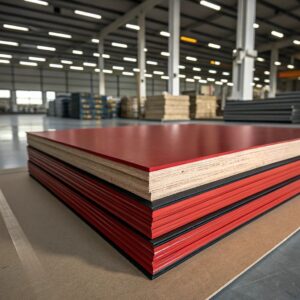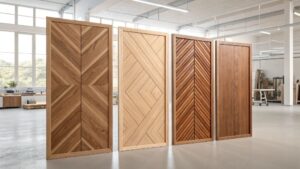
Are you confused about which engineered wood product suits your furniture project best? The wrong choice could cost you thousands in wasted materials and failed installations.
LVL (Laminated Veneer Lumber), LVB (Laminated Veneer Board), and normal plywood serve different structural purposes in woodworking. LVL offers superior strength for load-bearing applications, LVB provides balanced performance for semi-structural uses, while normal plywood excels in furniture-making with its workability and aesthetic appeal.
As a factory owner who's supplied wood panels to 37 countries, I've seen how choosing the wrong material can ruin projects. Let me break down these three options so you can make informed decisions.
1.What Is LVL? (Structural Features, Uses, Pros & Cons)

Ever needed wood that won't bend or warp under heavy weight? That's when LVL1 becomes your best friend in construction projects.
LVL is made by bonding thin wood veneers2 with parallel grain orientation under heat and pressure. This creates exceptional strength along the grain, making it ideal for beams, headers, and structural supports3 where normal wood would fail.
Why LVL Stands Out in Construction
- Grain Alignment: All veneers face the same direction (unlike plywood's cross-grain pattern)
- Thickness Range: Typically 1.75" to 3.5" for heavy-duty applications
- Moisture Resistance: Superior to solid lumber but less than treated plywood
Common Uses:
- Roof beams
- Floor joists
- Window/door headers
- Concrete formwork
Advantages:
✔ Consistent strength properties
✔ Minimal shrinkage/warping
✔ Available in long lengths (up to 60 feet)
Disadvantages:
✖ Poor screw-holding capacity at edges
✖ Limited aesthetic appeal for visible applications
✖ Higher cost than dimensional lumber
While we don't produce LVL at ACEALL, we often recommend it to clients needing structural elements for furniture frameworks. The next material, LVB, serves different needs.
2.What Is LVB? (How It Differs From LVL)

Need something stronger than plywood but more versatile than LVL? LVB strikes the perfect balance for semi-structural applications.
LVB shares LVL's manufacturing process but uses alternating grain directions like plywood. This cross-grain construction gives it multi-directional strength while maintaining better workability than LVL.
Key Differences Between LVB and LVL
| Feature | LVB | LVL |
|---|---|---|
| Grain Pattern | Cross-directional | Parallel |
| Strength | Multi-directional | Unidirectional |
| Thickness | 12mm-30mm | 45mm-90mm |
| Best For | Subflooring, wall panels | Beams, load-bearing |
Why Choose LVB?
- Easier to cut and shape than LVL
- More stable than plywood in humid conditions
- Better screw retention than LVL
- Cost-effective for medium-load applications
At our Zhejiang factory, we've noticed North American clients increasingly using LVB for:
- Cabinet carcasses
- Table bases
- Exhibition stand structures
- Store fixture backwalls
3.What Is Normal Plywood? (Especially Furniture-Grade)

Working on a furniture project where appearance matters as much as strength? Furniture-grade plywood should be your go-to material.
Normal plywood consists of thin wood layers (plies) bonded with adhesives in alternating grain directions. Furniture-grade versions feature defect-free face veneers of attractive wood species.
Furniture Plywood Characteristics
Core Types:
- Poplar Core: Lightweight, stable, preferred for painted furniture
- Combi Core: Mixed species for cost efficiency
- Full Birch Core: Premium option for heavy-duty furniture
Surface Options:
- Natural wood veneers (oak, walnut, maple)
- Printed decorative papers
- Melamine laminates (our specialty at ACEALL)
Why Furniture Makers Love It:
✔ Takes stains and finishes beautifully
✔ Resists warping better than solid wood
✔ Available in various thicknesses (3mm-25mm)
✔ Cost-effective for large surface areas
Last month, we shipped 20 containers of 18mm melamine-faced plywood to a Toronto furniture maker - their perfect solution for ready-to-assemble cabinets.
4.Main Differences Between LVL, LVB and Normal Plywood
Choosing between these materials? This comparison table highlights their key differences:
| Parameter | LVL | LVB | Normal Plywood |
|---|---|---|---|
| Primary Use | Structural | Semi-structural | Furniture/cabinetry |
| Grain Pattern | Parallel | Cross-alternating | Cross-alternating |
| Thickness Range | 45mm-90mm | 12mm-30mm | 3mm-25mm |
| Workability | Difficult | Moderate | Excellent |
| Aesthetics | Poor | Fair | Good-Excellent |
| Cost | $$$ | $$ | $-$$ |
| Moisture Resistance | Medium | Medium-High | Varies by type |
Real-World Example: For a bookshelf:
- LVL: Overkill (unless holding extreme weight)
- LVB: Good for structural frame
- Plywood: Ideal for shelves and panels
5.Which Is Better for Furniture Industry?
The answer depends on your specific furniture application:
For Structural Components:
- Bed frames: LVB edges
- Table bases: LVB or thick plywood
- Chair legs: LVL (for heavy-duty versions)
For Visible Surfaces:
- Cabinet doors: Furniture-grade plywood
- Tabletops: High-grade plywood with veneer
- Shelving: 18mm+ plywood with melamine finish
Our Canadian client Cathy's solution:
She uses:
- LVB for wardrobe frames
- 18mm melamine plywood for shelves
- 12mm plywood with oak veneer for doors
This combination gives her products durability while maintaining competitive pricing.
6.ACEALL's Recommendations and Products
After supplying wood panels to furniture makers worldwide, here are our top suggestions:
For Budget-Conscious Buyers:
- 15mm Poplar Core Melamine Plywood
- Available in 50+ decorative patterns
- MOQ: 1x20' container
For Premium Furniture Lines:
- 18mm Full Birch Core with Real Wood Veneer
- CARB P2 compliant
- Custom sizes available
Why Choose ACEALL?
- 8 production lines = faster delivery
- Strict QC: 5-point inspection system
- Custom lamination services
- 12-year experience in export markets
Special Offer: Mention this article when inquiring and get 3 free samples of our best-selling finishes.
Contact Us Now for your furniture panel needs - let's discuss how we can strengthen your product line with the right materials.
7.Conclusion
Understanding LVL, LVB and plywood differences ensures you select the right material for each furniture component. While LVL offers unmatched strength, furniture-grade plywood remains the versatile choice for visible surfaces.
-
Explore this link to understand how LVL wood can enhance your construction projects with its strength and durability. ↩
-
Discover the role of wood veneers in construction and how they contribute to the strength of materials like LVL. ↩
-
Learn about various materials for structural supports and why LVL is a top choice for heavy-duty applications. ↩



